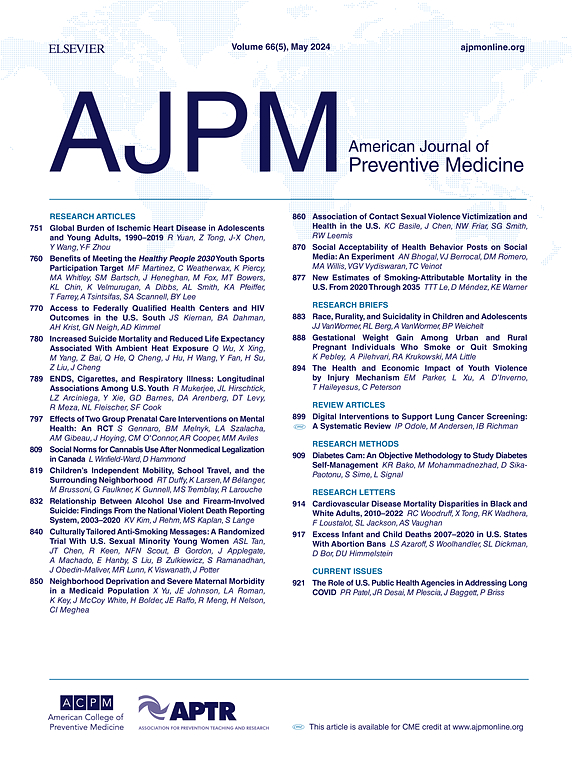Augmented Doses of Nicotine Replacement Therapy: Feasibility for Dual Cigarette and E-Cigarette Cessation
IF 4.3
2区 医学
Q1 MEDICINE, GENERAL & INTERNAL
引用次数: 0
Abstract
Introduction
Dual use of combustible cigarettes and e-cigarettes is common and has harmful health effects. Many who dual use want to quit, but there are no empirically supported dual cessation interventions. High-dose nicotine replacement therapy is effective for treating heavy smoking and may be applied to treating dual use of combustible cigarettes and e-cigarettes.
Methods
In this pilot feasibility trial, individuals using both combustible cigarettes and e-cigarettes who wanted to quit were randomly assigned to a 28-day supply of nicotine replacement therapy in one of 3 doses: Standard (21mg patch, qd + 4mg lozenge prn [minimum of 5, up to 20/day]); Mid (21mg patch + 14mg patch + 4mg lozenge [5–30/day]), or High (2 × 21mg patches + 4mg lozenges [5–40/day]). Participants reported combustible cigarette and e-cigarette use daily throughout treatment and 1-month follow-up.
Results
Participants enrolled in the study (N=46 from 2023 to 2024, analyzed 2025) had high nicotine dependence and most completed study procedures. Participants in the Mid group reported using nicotine replacement therapy on more days relative to the other groups. Participants in Mid and High reported numerically higher 7-day point-prevalence dual abstinence at end of treatment (13% for both groups vs 6% Standard) and follow-up (33% for both groups vs 0% Standard). Generaelized estimating equation models showed a significantly higher likelihood of abstinence on a given day for the Mid and High groups relative to Standard (ps<0.05).
Conclusions
Augmented doses of nicotine replacement therapy are a feasible, promising treatment for dual cessation of combustible cigarettes and e-cigarettes. Future research should evaluate this approach in a more rigorous, fully powered trial.
Trial Registration
This study is registered at www.clinicaltrials.gov NCT06087328.
增加尼古丁替代疗法的剂量:双烟和电子烟戒烟的可行性。
简介:可燃香烟(CC)和电子烟(EC)的双重使用是常见的,对健康有有害影响。许多双重使用的人想要戒烟,但没有经验支持双重戒烟干预措施。大剂量尼古丁替代疗法(NRT)是治疗重度吸烟的有效方法,可用于治疗CC和EC的双重使用。方法:在这项试点可行性试验中,同时使用CC和EC的患者被随机分配到三种剂量之一的28天NRT供应:标准(21mg贴片,qd + 4mg含片,prn[最少5个,最多20个/天]);中剂量(21mg贴片 + 14mg贴片 + 4mg含片[5-30/天])或高剂量(2个 × 21mg贴片 + 4mg含片[5-40/天])。参与者报告在整个治疗过程和1个月的随访期间每天使用CC和EC。结果:研究参与者(N=46,从2023年至2024年,分析2025年)具有高度的尼古丁依赖性,并且完成了大部分研究程序。与其他组相比,Mid组的参与者报告使用NRT的时间更长。中高组的参与者在治疗结束时报告了更高的7天点患病率双重戒断(两组为13%,标准组为6%)和随访(两组为33%,标准组为0%)。GEE模型显示,相对于标准组,中高剂量组在某一天戒断的可能性要高得多。结论:增加NRT剂量对于CC和EC的双重停止是一种可行的、有希望的治疗方法。未来的研究应该在更严格、更全面的试验中评估这种方法。
本文章由计算机程序翻译,如有差异,请以英文原文为准。
求助全文
约1分钟内获得全文
求助全文
来源期刊

American Journal of Preventive Medicine
医学-公共卫生、环境卫生与职业卫生
CiteScore
8.60
自引率
1.80%
发文量
395
审稿时长
32 days
期刊介绍:
The American Journal of Preventive Medicine is the official journal of the American College of Preventive Medicine and the Association for Prevention Teaching and Research. It publishes articles in the areas of prevention research, teaching, practice and policy. Original research is published on interventions aimed at the prevention of chronic and acute disease and the promotion of individual and community health.
Of particular emphasis are papers that address the primary and secondary prevention of important clinical, behavioral and public health issues such as injury and violence, infectious disease, women''s health, smoking, sedentary behaviors and physical activity, nutrition, diabetes, obesity, and substance use disorders. Papers also address educational initiatives aimed at improving the ability of health professionals to provide effective clinical prevention and public health services. Papers on health services research pertinent to prevention and public health are also published. The journal also publishes official policy statements from the two co-sponsoring organizations, review articles, media reviews, and editorials. Finally, the journal periodically publishes supplements and special theme issues devoted to areas of current interest to the prevention community.
 求助内容:
求助内容: 应助结果提醒方式:
应助结果提醒方式:


